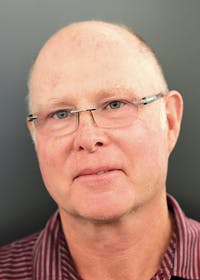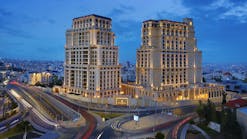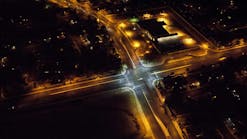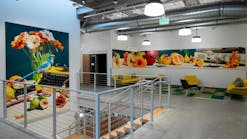Eaton describes the inspiration behind planar LED-based lighting for people spaces (MAGAZINE)
MAURY WRIGHT interviews KEN SIDERIUS relative to the LEDs Magazine Sapphire Award that Eaton won for the Invue Arbor luminaire that is based on a planar light guide optic.
LEDs Magazine announced the winners in the 2017 Sapphire Awards program on March 1, 2017 in Anaheim, CA, at a Gala that took place coincident with the Strategies in Light trade show. Longtime lighting manufacturing stalwart Eaton won the Sapphire Outdoor Street and Area Luminaire Design award for its Invue Arbor LED-based luminaire design. You can peruse the full list of winners in a feature article that we published on the awards. The Invue Arbor solid-state lighting (SSL) product is notable because it is based on an edge-lit planar light guide, yet targets the outdoor space. We recently had a chance to talk with Ken Siderius, marketing manager at Eaton, about the design of the Invue Arbor luminaire and how Eaton utilized technology that is more typically deployed indoors for lighting what the company refers to as outdoor people spaces.
Interested in articles & announcements on architectural lighting and the Sapphire Awards?
LEDs Magazine: Hi Ken, and congratulations on winning an LEDs Magazine Sapphire Award for your Eaton Invue Arbor outdoor luminaire. I want to start by asking you about the applications in which the luminaire can serve. It's certainly stylish and we will get to that shortly. But what is the application sweet spot in terms of lumen output and reasonable outdoor applications? We most often think of edge-lit, planar lighting products for use indoors. Indeed, Eaton has a large portfolio of indoor products based on the WaveStream optics or light guides. How did the inspiration come to the Eaton product development team to focus on an outdoor product based on WaveStream?
Ken Siderius: We were trying to solve a couple of issues we constantly heard from end users. One, the common LED optic development today by the SSL industry has realized exceptional net lumen output and efficacy but has lost focus on avoiding excessive brightness. Two, the use of discrete optic arrays has resulted in an unsightly pixelated image, which when used at a pedestrian scale, becomes distracting from the clarity of the visual environment. Both issues have a negative impact on our ability to quickly and accurately identify objects or access risk.
The development of the WaveStream technology solved both issues by managing brightness across a larger optical surface and presenting a non-pixelated image, therefore promoting task visibility. The resulting optical image is pleasant and comfortable to observe when mounted at pedestrian-scale heights and can promote the feeling of security that comes with the ability to better observe and avoid personal danger. The Arbor family can be used in many outdoor applications where "people spaces" are a priority. This includes streetscapes, campus environments, outdoor retail developments, etc.
LEDs: Innovative form factor is a very compelling area of LED-based lighting design. We are seeing completely new concepts in luminaire design indoors and out. Still, form without function is not a good answer to any lighting project. How did the Eaton team deliver performance and light quality for the pedestrians that will be the subjects that walk, interact, and live under the Invue Arbor products?
Siderius: Our focus was on improving the pedestrian experience. The day-form appearance of the product reflects the cultural value we assign to nature and the environment, therefore becoming an important design element in the creation of outdoor people spaces. WaveStream technology was employed to create an exceptional nighttime appearance while focusing on safe and secure wayfinding. The net result was a product that becomes intimate with the pedestrian, reflecting the value of the space so others will value it as well. Most of the time when evaluating a lighting solution at night, the focus of the solution is the delivered light. Arbor addresses this while also giving as much focus to the day-form and night-form appearance of the luminaire itself.
LEDs: What did the Eaton engineering team have to do to adapt the WaveStream optics for use in an outdoor product? Was it a straightforward process? Did you have to reinvent the optic to get the desired outdoor beam patterns?
Siderius: Optically, creating outdoor NEMA distributions was definitely a challenge, especially at the pedestrian scale we were targeting. Unlike parking lots where the top of a person's head is illuminated, we wanted to light the faces of people. The focus was on promoting pedestrian facial recognition while managing light output near or above the horizon responsible for glare or light pollution. We also allowed light behind the pole to promote security in pathway applications.
LEDs: What beam patterns can be delivered by the Invue Arbor design? What might be possible going forward?
Siderius: NEMA types II, III, IV, and V are all available for street and area applications. Future development is focused on increasing optical efficiencies and driving lower energy consumption without compromising lighting quality.
LEDs: We know that many luminaire designs indoors and out look like legacy fixtures with LEDs supplanting a lamp of some type. Clearly, Invue Arbor and some of your other products are far different from legacy fixtures. How does your team start a product development like Invue Arbor? Do you conceive of the shape and lines before even contemplating how to make it work optically? Is there an industrial design-type process that happens before you tackle the electrical, mechanical, optical, and thermal problems?
Siderius: For over 12 years Eaton has developed a massive equity in North American manufacturing and design of LED technology. We have talented industrial design and product development teams working out of our Peachtree City Innovation Center. WaveStream technology opens up new possibilities for shape and size that inspire new design language. Once the outer boundaries of the optics and mechanical needs are defined by the development team, our industrial designers create what they feel suits modern trends in architectural design and cultural values. The final design is the result of collaborations from sales, marketing, manufacturing, quality, end users, and suppliers.
LEDs: How is the light engine implemented in Invue Arbor? The LEDs must be hidden in the outer ring. What type of LEDs are used (mid or high power)? Where is the driver? Are the surfaces of the outer ring sufficient for thermal management or are there thermal elements that we don't see?
Siderius: The LED modules are located within the outer ring and integrally thermal managed to operate in an overall ambient environment of 40°C. Our thermal management for the driver and LEDs far exceeds the typical 25°C nighttime environment to promote extended product life and lumen maintenance.
LEDs: What are the limits of WaveStream in outdoor applications? Can it or is it serving in street-lighting applications or is area lighting the limit? What do you need to do to serve street lighting? We know that edge-lit planar light engines can reduce glare, and isn't that a good idea for all outdoor lighting?
Siderius: The purpose of WaveStream was to create products for use in people spaces, rather than lighting large parking spaces. WaveStream is best suited, but not limited to, campus applications such as hospitals and universities, public parking garages, downtown commercial public spaces, or streets. The optics have been optimized for mounting heights of 10 to 24 ft, where the product is required to become more intimate with the pedestrian, assisting in wayfinding while promoting the value of the space. Just as with any LED platform, our talented team of designers and engineers will continue to push where we can utilize our WaveStream technology.
LEDs: Winning awards is nothing new for Eaton and indeed you have your own Source Awards for lighting design. Still, we hope you consider the Sapphire Award among the top achievements for Invue Arbor. How did you make the decision to enter our Sapphire program? And what was the reaction of your product team to the win?
Siderius: We are excited to have been recognized with such a prestigious award. It validates the many hours of work and risks we take to create innovative products and advance lighting design to state of the art.
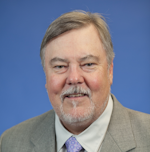
Maury Wright | Editor in Chief
Maury Wright is an electronics engineer turned technology journalist, who has focused specifically on the LED & Lighting industry for the past decade. Wright first wrote for LEDs Magazine as a contractor in 2010, and took over as Editor-in-Chief in 2012. He has broad experience in technology areas ranging from microprocessors to digital media to wireless networks that he gained over 30 years in the trade press. Wright has experience running global editorial operations, such as during his tenure as worldwide editorial director of EDN Magazine, and has been instrumental in launching publication websites going back to the earliest days of the Internet. Wright has won numerous industry awards, including multiple ASBPE national awards for B2B journalism excellence, and has received finalist recognition for LEDs Magazine in the FOLIO Eddie Awards. He received a BS in electrical engineering from Auburn University.
